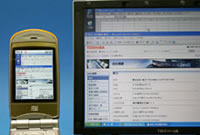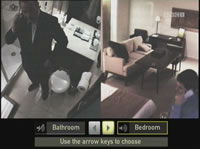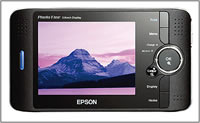 Toshiba has announced software to remotely execute programs on a PC, via a mobile phone. They call it Ubiquitous Viewer.
Toshiba has announced software to remotely execute programs on a PC, via a mobile phone. They call it Ubiquitous Viewer.
Software that gives remote access to your computer from another has been available for years, with a particular favourite within the Digital Lifestyles offices being the open source VNC (Virtual Network Computing).
The way these packages used to work, was by an application running on the host (remote) computer and another on the client (local). Keystrokes and mouse movements are read from the client, sent over a communication line (dialup/IP) and executed on the host. Graphical changes to the screen on the host machine are collected, compressed, sent down the line and replicated on the client.
While this approach is basic, it has the advantage that any software application could be run.
The details of Toshiba’s Ubiquitous Viewer are still sketchy, but what we do know is it’ll allow users to open productivity software, such as the MS Office suite, and to read and modify files. It also supports access to PC-based e-mail, Internet browser and other PC applications.
Internet browsing through a phone to your PC? This is the only one we find a little bizarre, it’s a bit like reading a book through a telescope.
Given the support for “other PC applications” and the photograph, the Ubiquitous Viewer looks like it works on the same principles as the old-school solutions.
To access the remote machine, a password must be entered once. The transfer of data is over a secure connection, as it uses the Web standard secure socket layer (SSL) encryption
The service will initially be released at the end of March 2005 in Japan on KDDI’s service using CDMA1X mobile phones. Following this, they intend to take it other countries.
Quite what the experience will be like on a mobile screen is unclear and frankly this type of solution will only be used in desperation when you must have access to some information that you’ve forgotten.
It is a good example in our view of the future – no matter what the restrictions of the device, any that provides access will be acceptable, until you can move to a location or device that is superior.
 More recently the BBC has claimed to offer yet another enhanced drama first with interactive Spooks. The third series of this successful spy drama began transmission on BBC1 Monday 11 October. Unlike Family Affairs’ tentative foray into interactivity, viewers will not be voting on Spooks storylines. (If they could, they’d most certainly vote to keep Tom Quinn, the main character played by Matthew Macfadyen who exits the show in Episode 3.) Instead immediately after the programme, digital viewers are invited to find out if they have what it takes to make it as a spy. Led by Harry Pearce (a crossover character from the television series portrayed by Peter Firth), participants take a series of scored tests that examine essential espionage skills such as memory, reaction and observation. From Episode 6 viewers will be able to participate in a mission that was written by Steve Bailie, an experienced writer of television drama. “The aim,” Sophie Walpole BBC’s Head of Interactive Drama & Entertainment told us, “is to offer fans a deeper relationship with both the programme and its characters.” In addition, Walpole pointed out, “fans will get something back – they’ll get to know a little about themselves.”
More recently the BBC has claimed to offer yet another enhanced drama first with interactive Spooks. The third series of this successful spy drama began transmission on BBC1 Monday 11 October. Unlike Family Affairs’ tentative foray into interactivity, viewers will not be voting on Spooks storylines. (If they could, they’d most certainly vote to keep Tom Quinn, the main character played by Matthew Macfadyen who exits the show in Episode 3.) Instead immediately after the programme, digital viewers are invited to find out if they have what it takes to make it as a spy. Led by Harry Pearce (a crossover character from the television series portrayed by Peter Firth), participants take a series of scored tests that examine essential espionage skills such as memory, reaction and observation. From Episode 6 viewers will be able to participate in a mission that was written by Steve Bailie, an experienced writer of television drama. “The aim,” Sophie Walpole BBC’s Head of Interactive Drama & Entertainment told us, “is to offer fans a deeper relationship with both the programme and its characters.” In addition, Walpole pointed out, “fans will get something back – they’ll get to know a little about themselves.”  Designed as a replacement for Epson’s P-1000, the imaginatively named P-2000 has higher capacity storage, a faster interface, two memory card slots and the ability to view, store and playback photos, videos and music. If you are still nostalgic about the black and white photos taken in the back garden with the Brownie camera, just think of the multi-sensorial memories your kids will have.
Designed as a replacement for Epson’s P-1000, the imaginatively named P-2000 has higher capacity storage, a faster interface, two memory card slots and the ability to view, store and playback photos, videos and music. If you are still nostalgic about the black and white photos taken in the back garden with the Brownie camera, just think of the multi-sensorial memories your kids will have.